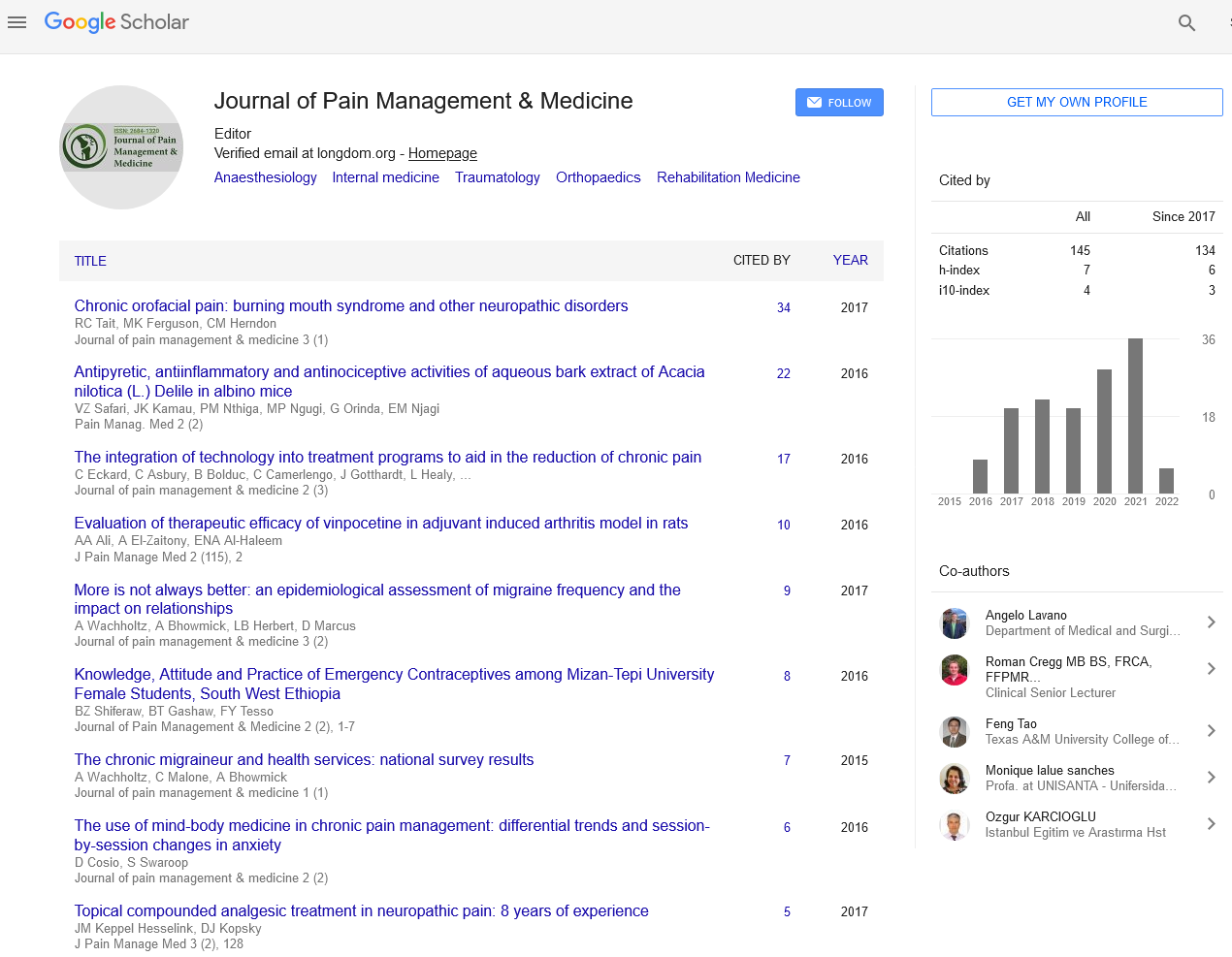Indexed In
- RefSeek
- Hamdard University
- EBSCO A-Z
- Publons
- Euro Pub
- Google Scholar
- Quality Open Access Market
Useful Links
Share This Page
Journal Flyer

Open Access Journals
- Agri and Aquaculture
- Biochemistry
- Bioinformatics & Systems Biology
- Business & Management
- Chemistry
- Clinical Sciences
- Engineering
- Food & Nutrition
- General Science
- Genetics & Molecular Biology
- Immunology & Microbiology
- Medical Sciences
- Neuroscience & Psychology
- Nursing & Health Care
- Pharmaceutical Sciences
Commentary - (2020) Volume 6, Issue 2
Test of Pain Therapy in Severe Mental Damage
Sweety Dash*Received: 16-Jul-2020 Published: 28-Jul-2020, DOI: 10.35248/2684-1320.20.6.142
Commentary
The standard strategy for evaluating viability of agony treatment is to request the patient's self-appraisal of his/her torment level and to change treatment dependent on this self-evaluation. This proportion of agony is based on the suspicions that the patient can talk and has adequate intellectual capacity to self-survey and report torment levels. The treatment of torment turns into a genuine test when the patient has intellectual impedance that meddles with discourse or the capacity to convey torment levels. There are no as of now natural markers accessible to dependably survey torment [1]. This implies there can be no agony rating without an emotional report of torment by the patient [2].
In their old style work, Melzack and Wall [3] characterized torment as having tangible descriminative, full of feeling inspirational, and cognitiveevaluative segments. These parts are adjusted by the parallel agony framework and the average pathway. Dementia of Alzheimers type appears to influence the average torment framework yet not the parallel framework. These progressions would will in general infer that the patient with extreme psychological disability from Alzheimers infection would have torment yet not have the option to report the agony. Clinicians are confronted with an issue regarding how to assess torment levels and treatment adequacy in these patients. A few ways to deal with understanding torment in individuals with serious intellectual weakness have been tried with blended outcomes.
One methodology has been to endeavor to create conduct markers that could fill in as intermediary proportions of agony in patients with extreme intellectual disability. Until this point, these methodologies have not been promising with the exception of in mellow and moderate intellectual disability. This might be on the grounds that serious psychological disability blunts these practices.
Another methodology has been to endeavor to create torment scales that would be substantial and dependable in individuals with intellectual disability. An audit of 10 agony conduct instruments didn't recognize any that were worthy for clinicians to use in patients with patients with extreme intellectual debilitation. Right now, no social instruments have been made with adequate unwavering quality and legitimacy for use in patients who are non-verbal or who have extreme intellectual impedance.
Do patients with serious intellectual weakness have torment? We don't be able to respond to this inquiry as of not long ago. The advancement of useful attractive reverberation imaging (fMRI) specialists just because to decide whether the torment pathways in the cerebrum stay unblemished as extreme intellectual hindrance advances. Primer work shows that the horizontal and average agony pathways stay unblemished in people with dementia of Alzheimer's sort. This would appear to show that these patients have tangible and passionate torment recognition however not have the option to communicate this torment.
Considerably more work must be finished to more readily comprehend the impacts of intellectual impedance on torment pathways in patients especially those with extreme hindrance. Clinicians can't depend on existing torment estimations to precisely survey torment in this patients nor the reaction of these patients to torment treatment. We should expect that patients with serious intellectual impedance do have torment and rewarded suitably in any event, when they can't report their agony.
REFERENCES
- Davis MP, Srivastava M. Demographics, assessment and management of pain in the elderly. Drugs & Aging. 2003;20:23-57.
- Pasero C, McCaffery M. PAIN control. No self-report means no pain-intensity rating: assessing pain in patients who cannot provide a report. Am J Nsg. 2005;105:50-53.
- Melzack R, Wall D. The challenge of pain London: Penguin Books. 1988.
Citation: Sweety Dash (2020) Test of Pain Therapy in Severe Mental Damage. J Pain Manage Med 6: 142. doi: 10.35248/2684-1320.20.6.142
Copyright: © 2020 Sweety D. This is an open access article distributed under the terms of the Creative Commons Attribution License, which permits unrestricted use, distribution and reproduction in any medium, provided the original work is properly cited.


